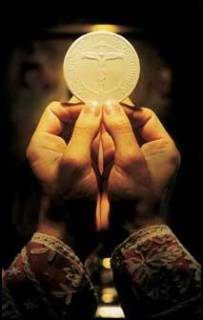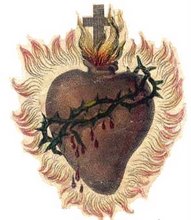Great Clouds of Incense
I love to use incense at the Holy Mass. It helps to support an atmosphere of solemnity and beauty that is fitting to the greatest gift given by Christ to His Church, and the highest prayer the Church has to offer to God: the True Worship of God the Father as offered by Christ on His Cross. It helps man to understand that at Mass we enter into and are united with the worship offered God in Heaven by His Angels and Saints. If we are told, after all, that the angels stand amid clouds of incense singing God's praise in heaven, why shouldn't they do the same gathered around the altar, as they are, singing God's praise during the Holy Sacrifice of the Mass?
Even though I think most people have a "gut" instinct about incense, one of the questions I often get after using incense at Mass is, "Why do you use incense?" or "What does the incense mean?" This great article from The Catholic Education Resource Center gives a great history of the liturgical use of incense, its symbolism, and its importance.
Questions and comments are welcome.
God love you!
************
THOMAS J. CRAUGHWELL
An unusual tree grows in the sultanate of Oman.
In the temple rituals of the ancient world incense played a symbolic and a practical role. Because it was rare, expensive, and would be completely consumed by fire, it was considered a suitable sacrifice to the gods. Furthermore, priests and people hoped that their prayers would rise to heaven like the great clouds of sweet-smelling smoke. Then there was the practical dimension of burning incense: in temples where animals were sacrificed and their carcasses burned, incense helped mask the stench.
Both the Old and the New Testaments tell us that incense is pleasing to God. In the book of Exodus God commands Moses to build a small, gold-plated altar specifically for burning incense every morning and evening (Exodus 30:1-8). In St. Luke’s gospel we read that St. Zachary the priest was about to offer incense in the Temple in Jerusalem when the archangel Gabriel appeared to announce that he and his wife Elizabeth were about to have a son, the future St. John the Baptist (Luke 1:8-13). And the book of Revelations describes a scene in Heaven in which an angel burned incense in a censer, “and the smoke of the incense rose with the prayers of the saints… before God” (Revelations 8:3-4).
In spite of biblical endorsement of the practice, there is no evidence that Christians during the first three hundreds of the Church used incense at Mass. Perhaps Christians worried that clouds of incense billowing from their little house-churches would have attracted unwanted attention. Another reason is more probable: among the early Christians incense stirred up unhappy memories. During periods of persecution, Roman magistrates always offered a Christian the chance to save his or her life by burning a few grains of incense before an image of a pagan god. Christians who refused were executed, while those who out of a natural fear of pain and death complied and burned the incense became a source of shame and heartache for their fellow Christians.
For reasons are hard to pin down, by the late 4 th century the Church in the East had begun to use incense in worship. Etheria, a nun from present-day France who in 381 began a lengthy pilgrimage to the Holy Land, tells us that incense was burned in the Church of the Holy Sepulcher in Jerusalem. As the bitter memory of incense’s link to the era of persecution faded, the Church in the West took up the custom, too, censing everything that was considered holy—the bread and wine, the altar, the crucifix, the book of the gospels, the celebrant of the Mass and the sacred ministers, and the congregation. Today incense serves the same purpose as it did when Moses burned it in the desert—it pays homage to all that is holy, and symbolizes our prayers ascending to God.
ACKNOWLEDGEMENT
Thomas J. Craughwell. "Great Clouds of Incense." Our Sunday Visitor.



5 comments:
I love incense! That's one of the reasons I love Benediction at the end of Adoration. :-)
I get a headache from incense and it causes problems for my son who has asthma. I also fear that incense is carcinogenic and wish we did not have to endure it at Mass every sunday.
I am sorry this happens to you! The use of incense in the worship of God dates back more than 3,000 years and is a beautiful sacramental. Perhaps when you knew that they were going to use incense you could sit near the back of the church. As for it being carcinogenic, perhaps if you stood above the thurible breathing it in, but with the small amount in a large area I think it's effects on health are negligible.
God love you!
Interesting background about incense. I am preaching about the fragrance of Jesus today.
Thank you and bless you.
Father
Thank you for the great explanantion. My husband, who is soon to enter in to the Catholic church, asked why we burn incense. I had no "real" answer, but I did have an inkling. Your description was excellent
Blessings
D n B
Post a Comment